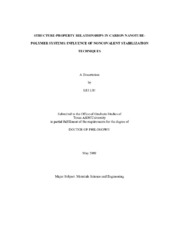| dc.contributor.advisor | Grunlan, Jaime C. | |
| dc.creator | Liu, Lei | |
| dc.date.accessioned | 2010-01-20T21:16:22Z | |
| dc.date.available | 2010-01-20T21:16:22Z | |
| dc.date.created | 2009-05 | |
| dc.date.issued | 2010-01-20 | |
| dc.identifier.uri | https://hdl.handle.net/1969.1/ETD-TAMU-2009-05-520 | |
| dc.description.abstract | A variety of experiments were carried out to study the dispersion and
microstructure of carbon nanotubes in aqueous suspensions and polymer composites
with the goal to improve the electrical conductivity of the composites containing
nanotubes. Epoxy composites containing covalently and noncovalently functionalized
nanotubes were compared in terms of electrical and mechanical behavior. Covalent
functionalization of nanotubes is based on chemical attachments of polyethylenimine
(PEI) whereas noncovalent functionalization takes place through physical mixing of
nanotubes and PEI. The electrical conductivity is reduced in composites containing
covalently functionalized nanotubes due to damage of the tube?s conjugated surface that
reduces intrinsic conductivity. Conversely, the mechanical properties are always better
for epoxy composites containing covalently functionalized nanotubes.
Clay particles were used as a rigid dispersing aid for nanotubes in aqueous
suspensions and epoxy composites. When both nanotubes and clay were introduced into
water by sonication, the suspension is stable for weeks, whereas the nanotubes precipitate almost instantly for the suspension without clay. In epoxy composites,
nanotubes form separated clusters of aggregation, whereas a continuous threedimensional
nanotube network is achieved when clay is introduced. Electrical
conductivity of the epoxy composite is shown to significantly improve with a small
addition of clay and the percolation threshold is simultaneously decreased (from 0.05
wt% nanotubes, when there is no clay, to 0.01 wt% when 2 wt% clay is introduced). The
addition of clay can also improve the mechanical properties of the composites, especially
at higher clay concentration.
Weak polyelectrolytes (i.e., pH-responsive polymers) were also studied for their
interaction with nanotubes and the electrical properties of the dried composite films.
When dispersed by sonication, Nanotubes show pH-dependent dispersion and stability in
poly(acrylic acid) water solution, as evidenced by changes in suspension viscosity and
cryo-TEM images. The nanotube suspensions were then dried under ambient conditions
and the composite films exhibit tailorable nanotube dispersion as a function of pH. The
percolation threshold and maximum electrical conductivity are reduced when the pH is
changed from low to high. Some other pH-responsive polymers were also studied, but
their pH-dependent viscosity and conductivity were not as large or reversible as
poly(acrylic acid). | en |
| dc.format.mimetype | application/pdf | |
| dc.language.iso | en_US | |
| dc.subject | Keyword 1 | en |
| dc.subject | Carbon Nanotube 2 | en |
| dc.subject | Aqueous Suspension 3 | en |
| dc.subject | Polymer Composites 4 | en |
| dc.subject | Dispersion and Microstructure 5 | en |
| dc.subject | Structure-Property Relationship | en |
| dc.title | Structure-Property Relationships in Carbon Nanotube-Polymer Systems: Influence of Noncovalent Stabilization Techniques | en |
| dc.type | Book | en |
| dc.type | Thesis | en |
| thesis.degree.department | Mechanical Engineering | en |
| thesis.degree.discipline | Materials Science and Engineering | en |
| thesis.degree.grantor | Texas A&M University | en |
| thesis.degree.name | Doctor of Philosophy | en |
| thesis.degree.level | Doctoral | en |
| dc.contributor.committeeMember | Ounaies, Zoubeida | |
| dc.contributor.committeeMember | Cheng, Zhengdong | |
| dc.contributor.committeeMember | Yu, Choongho | |
| dc.type.genre | Electronic Dissertation | en |


